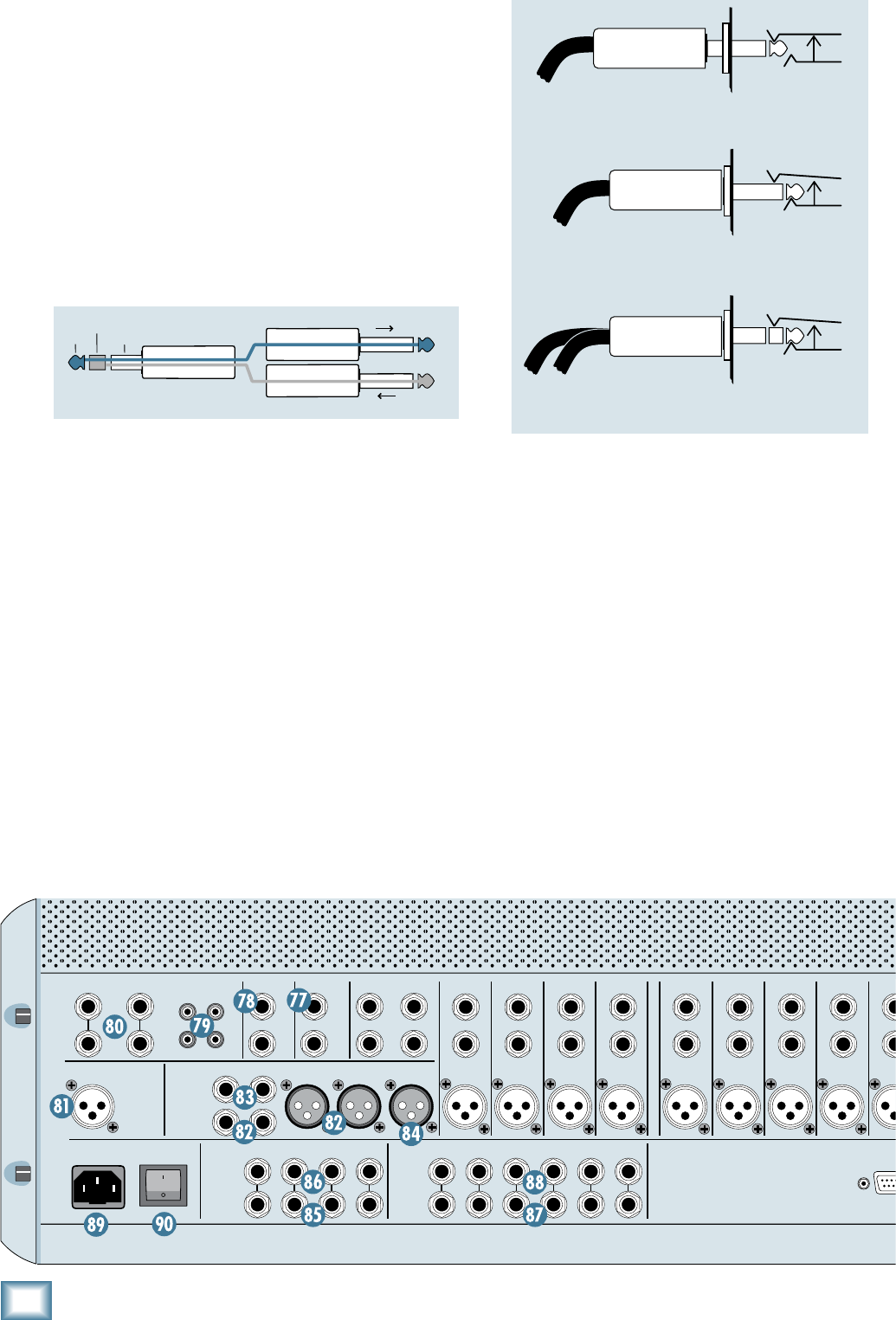
ONYX 4•Bus
ONYX 4•Bus
75. INSERT
These 1/4
"
TRS jacks provide a send and return point
for each channel. Use the INSERT jacks to connect
serial effects devices such as compressors,
equalizers,
de-essers, or filters to each individual channel.
The INSERT points are after the GAIN and Low Cut
controls, but before the EQ and Fader controls. The
send (tip) is low-impedance, capable of driving any
device. The return (ring) is high-impedance and can be
driven by almost any device.
Special insert cables are available, specially designed
for this kind of insert jack. They are wired as follows:
“from tip”
this plug connects to one of the
mixer’s Channel Insert jacks.
“to ring”
tip
ring
sleeve
SEND to processor
RETURN from processor
(TRS plug)
Tip = Send (output to effects device)
Ring = Return ( input from effects device)
Sleeve = Common ground (connect shield to all
three sleeves)
Besides being used for inserting external devices,
these jacks can also be used as channel direct outputs;
post-GAIN, post-LOW CUT, and pre-EQ. This is an unbal-
anced direct out, in contrast to the DIRECT OUTS on
the rear panel, which are balanced direct outputs, post-
GAIN, post-INSERT, and pre-EQ.
Here are three ways you use the INSERT jacks:
Direct out with no signal interruption to master.
Insert only to first “click.”
Channel Insert jack
Channel Insert jack
Channel Insert jack
Direct out with signal interruption to master.
Insert all the way in to the second “click.”
For use as an effects loop.
(TIP = SEND to effect, RING = RETURN from effect)
MONO PLUG
MONO PLUG
STEREO
PLUG
76. DIRECT OUTS
Each of these DB-25 connectors provides balanced
direct outputs for eight channels. They are designed to
be connected directly to a recorder’s analog inputs, and
use the TASCAM standard pinout for analog signal con-
nections (the same standard used on the analog cards
for the Mackie D8B, DXB, and Hard Disk Recorder).
The signal at the DIRECT OUTS comes after the input
GAIN control, Low-Cut switch, and INSERT jack, but
before the EQ. This way you can EQ a channel and ad-
just the channel fader to suit your live mix, but it has no
effect on the signal going to the recorder. This provides
maximum flexibility for the mixdown stage.
CAUTION
INSERT
1
INSERT
2
INSERT
3
INSERT
4
INSERT
5
INSERT
6
INSERT
7
INSERT
8
INSERT
9
INSERT
10
INSERT
11
INSERT
12
INSERT
13
INSERT
14
INSERT
15
INSERT
16
INSERT
17
INSERT
18
INSERT
19
INSERTINSERTINSERTINSERTINSERTINSERTINSERTINSERTINSERT
20
MTRX OUT
POWER
ON
B
A
MON OUT
R
L
29
30
31
32
R
L
R
L
LINE
LINE IN LINE IN
BAL/UNBAL
BAL/UNBALBAL/UNBAL
BAL/UNBAL
BAL/UNBAL BAL/UNBAL
BAL/UNBAL
MONOMONO
BAL/UNBAL
O
N
Y
X
M
I
C
P
R
E
O
N
Y
X
M
I
C
P
R
E
O
N
Y
X
M
I
C
P
R
E
O
N
Y
X
M
I
C
P
R
E
O
N
Y
X
M
I
C
P
R
E
O
N
Y
X
M
I
C
P
R
E
O
N
Y
X
M
I
C
P
R
E
O
N
Y
X
M
I
C
P
R
E
O
N
Y
X
M
I
C
P
R
E
MIC
21
LINE
BAL/UNBAL
MIC
LINE
BAL/UNBAL
O
N
Y
X
M
I
C
P
R
E
MIC
LINE
BAL/UNBAL
O
N
Y
X
M
I
C
P
R
E
MIC
LINE
BAL/UNBAL
O
N
Y
X
M
I
C
P
R
E
MIC
LINE
BAL/UNBAL
O
N
Y
X
M
I
C
P
R
E
MIC
LINE
BAL/UNBAL
O
N
Y
X
M
I
C
P
R
E
MIC
LINE
BAL/UNBAL
O
N
Y
X
M
I
C
P
R
E
MIC
LINE
BAL/UNBAL
O
N
Y
X
M
I
C
P
R
E
MIC
LINE
BAL/UNBAL
O
N
Y
X
M
I
C
P
R
E
MIC
LINE
BAL/UNBAL
O
N
Y
X
M
I
C
P
R
E
MIC
LINE
BAL/UNBAL
O
N
Y
X
M
I
C
P
R
E
MIC
LINE
BAL/UNBAL
O
N
Y
X
M
I
C
P
R
E
MIC
O
N
Y
X
M
I
C
P
R
E
MIC
O
N
Y
X
M
I
C
P
R
E
MIC
O
N
Y
X
M
I
C
P
R
E
MIC
O
N
Y
X
M
I
C
P
R
E
MIC
O
N
Y
X
M
I
C
P
R
E
MIC
LINE
BAL/UNBAL
O
N
Y
X
M
I
C
P
R
E
MIC
LINE
BAL/UNBAL
LINE
BAL/UNBAL
LINE
BAL/UNBAL
LINE
BAL/UNBAL
LINE
BAL/UNBAL
LINE
BAL/UNBAL
O
N
Y
X
M
I
C
P
R
E
MIC
LINE
BAL/UNBAL
O
N
Y
X
M
I
C
P
R
E
MIC
4 3 2 1 6 5 4 3 2 1
RIGHT
2
1
TAPE
TALK BACK
MIC
22
LINE
BAL/UNBAL
MIC
23
LINE
BAL/UNBAL
MIC
24
LINE
BAL/UNBAL
MIC
25
LINE
BAL/UNBAL
MIC
26
LINE
BAL/UNBAL
MIC
27
LINE
BAL/UNBAL
MIC
28
LINE
BAL/UNBAL
MIC
GROUP
INSERTS
GROUP
OUTS
AUX
INSERTS
AUX
SENDS
MAIN
OUTS
MAIN
INSERTS
RIGHT LEFT
MAIN BALANCED OUTS
RIGHT LEFT MONO
OUTIN
OUTIN
R
L
R
L
STEREO RETURNS
DIRECT OUTS
POST GAIN / INSERT
(BALANCED) (BALANCED) (BALANCED)
1
-
8
9-16
17
-
24
(BALANCED)
25
-
32
LEFT
(MONO)


















